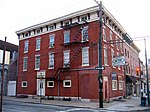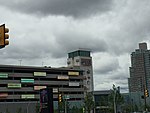Girard station (Market–Frankford Line)
Pennsylvania railway station stubsRailway stations in PhiladelphiaRailway stations in the United States opened in 1922SEPTA Market-Frankford Line stationsSEPTA Route 15 stations ... and 1 more
SEPTA stubs

Girard station is an elevated rapid transit station in Philadelphia, Pennsylvania, on SEPTA's Market-Frankford Line. It is located at the corner of Front Street and Girard Avenue in the Fishtown neighborhood. The station is also served by the Route 15, the historic Girard Avenue trolley line, which runs on tracks in the median of Girard Avenue. The trolley station is known as Front & Girard. SEPTA bus routes 5 and 25 also serve the station, as well as the Route 15 bus which temporarily replaced trolleys on the Richmond Street section of that line during I-95 construction.
Excerpt from the Wikipedia article Girard station (Market–Frankford Line) (License: CC BY-SA 3.0, Authors, Images).Girard station (Market–Frankford Line)
West Girard Avenue, Philadelphia
Geographical coordinates (GPS) Address Nearby Places Show on map
Geographical coordinates (GPS)
| Latitude | Longitude |
|---|---|
| N 39.9689 ° | E -75.1362 ° |
Address
Girard Avenue & Front Street
West Girard Avenue
19130 Philadelphia
Pennsylvania, United States
Open on Google Maps









